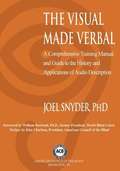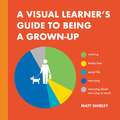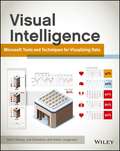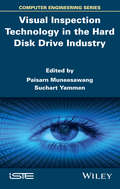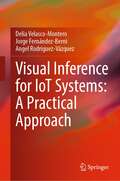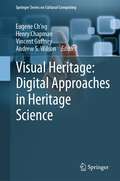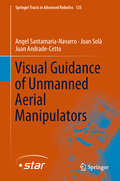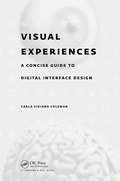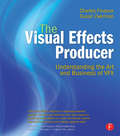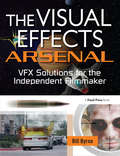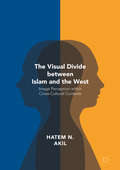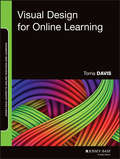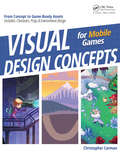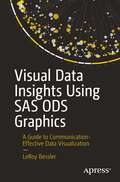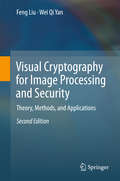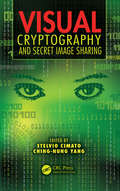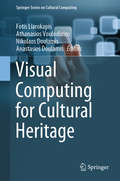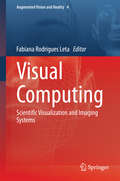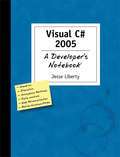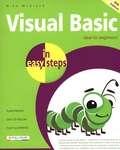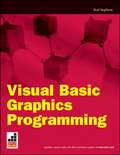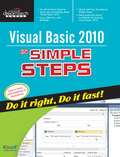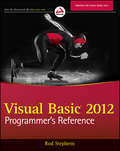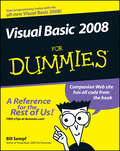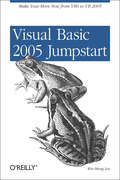- Table View
- List View
The Visual Made Verbal: A Comprehensive Training Manual and Guide to the History and Applications of Audio Description
by Joel SnyderVerbal descriptions of life have been around for centuries, but the digital age has made access to those descriptions even more important. Dr. Joel Snyder, an audio description pioneer, has created a book and website offering the first overview of the field, including its history, application to a range of genres, description of training techniques and list of resources. Audio description brings the visual world to life, making theater productions, television shows, films, visual art and events accessible to people who are blind or have low vision. Describers employ succinct, vivid, imaginative words to convey visual images those with sight take for granted. Although countries worldwide have taken up the cause, the United States has fallen short on research and institutions to study the field. Dr. Snyder's book helps fill in some of those gaps. "For decades, Joel Snyder has combined his astonishing command of language with his keen attention to detail to create word pictures that stir the mind's eye, especially for patrons of the arts whose physical eyes cannot see. ... His book has been long-awaited and no doubt will become the standard for prospective audio describers around the world." -- Kelsey Marshall, founding director of accessibility, John F. Kennedy Center for the Performing Arts in Washington, D.C. Dr. Joel Snyder is known internationally as one of the world's first "audio describers," a pioneer in the field of audio description: making theater events, museum exhibitions, and media accessible to people who are blind or have low vision. Since 1981, he has introduced audio description techniques in 36 states and D.C. and in 35 countries; he holds a Ph.D. in accessibility-audio description from the Universitat Autonoma de Barcelona. Dr. Snyder's company, Audio Description Associates, LLC (www.audiodescribe.com) uses audio description to enhance a wide range of arts projects including video and film, museum exhibitions and live events, As Director of Described Media for the National Captioning Institute, he supervised the production of description for Sesame Street and dozens of feature films and nationally broadcast television; his descriptions can be heard at Smithsonian Institution exhibits, the Getty Museum, the Albright-Knox Gallery and throughout the country at National Park Service visitor centers. As Director of the American Council of the Blind's Audio Description Project (www.acb.org/adp), Dr. Snyder voiced description for network coverage of President Obama's inauguration in 2009 and 2013 and recently produced the first-ever audio described tour of The White House; the ADP website is the nation's principal provider of information and resources on audio description.
A Visual Learner's Guide to Being a Grown-Up
by Matt ShirleyBased on Matt Shirley's popular Instagram account, this smart and hilarious guide is a collection of tables, lists, and charts for all the visual learners out there striving to be a successful grown-up.We all know the particular pain that comes with having to be an actual adult, whether it's resetting your internet password on ten different sites, yearning for an excuse to get out of the plans your wife made for you months ago, or the anxiety that comes from forcing yourself to work out again.When Matt Shirley became fed up with being a grown-up, he started drawing charts as a more fun and efficient way to cope with his frustrations, and stuck them up on Instagram where they became an instant hit. Packed with over one hundred charts, graphs, diagrams, and infographics—with 50 percent brand-new material—this hilarious collection vows to explain everything you need to know about how to be a grown-up, covering work, family, and friends, to dating, breakups, and more.From explaining the cycle of adulthood to decoding the pros and cons of first dates to understanding the corporate lingo translator, Shirley's charts cut to the core of how to be an adult in the funniest possible way.
Visual Intelligence
by Mark Stacey Joe Salvatore Adam JorgensenGo beyond design concepts and learn to build state-of-the-art visualizationsThe visualization experts at Microsoft's Pragmatic Works have created a full-color, step-by-step guide to building specific types of visualizations. The book thoroughly covers the Microsoft toolset for data analysis and visualization, including Excel, and explores best practices for choosing a data visualization design, selecting tools from the Microsoft stack, and building a dynamic data visualization from start to finish. You'll examine different types of visualizations, their strengths and weaknesses, and when to use each one. Data visualization tools unlock the stories within the data, enabling you to present it in a way that is useful for making business decisionsThis full-color guide introduces data visualization design concepts, then explains the various Microsoft tools used to store and display dataFeatures a detailed discussion of various classes of visualizations, their uses, and the appropriate tools for each Includes practical implementations of various visualizations and best practices for using themCovers out-of-the-box Microsoft tools, custom-developed illustrations and implementations, and code examplesVisual Intelligence: Microsoft Tools and Techniques for Visualizing Data arms you with best practices and the knowledge to choose and build dynamic data visualizations.
Visual Inspection Technology in the Hard Disc Drive Industry
by Suchart Yammen Paisarn MuneesawangA presentation of the use of computer vision systems to control manufacturing processes and product quality in the hard disk drive industry. Visual Inspection Technology in the Hard Disk Drive Industry is an application-oriented book borne out of collaborative research with the world's leading hard disk drive companies. It covers the latest developments and important topics in computer vision technology in hard disk drive manufacturing, as well as offering a glimpse of future technologies.
Visual Inference for IoT Systems: A Practical Approach
by Angel Rodríguez-Vázquez Jorge Fernández-Berni Delia Velasco-MonteroThis book presents a systematic approach to the implementation of Internet of Things (IoT) devices achieving visual inference through deep neural networks. Practical aspects are covered, with a focus on providing guidelines to optimally select hardware and software components as well as network architectures according to prescribed application requirements. The monograph includes a remarkable set of experimental results and functional procedures supporting the theoretical concepts and methodologies introduced. A case study on animal recognition based on smart camera traps is also presented and thoroughly analyzed. In this case study, different system alternatives are explored and a particular realization is completely developed. Illustrations, numerous plots from simulations and experiments, and supporting information in the form of charts and tables make Visual Inference and IoT Systems: A Practical Approach a clear and detailed guide to the topic. It will be of interest to researchers, industrial practitioners, and graduate students in the fields of computer vision and IoT.
Visual Heritage: Digital Approaches in Heritage Science (Springer Series on Cultural Computing)
by Eugene Ch'Ng Vincent Gaffney Henry Chapman Andrew S. WilsonHow we understand our shared and individual heritage, interpret and disseminate that knowledge is increasingly central to contemporary society. The emerging context for such development is the field of heritage science. Inherently interdisciplinary, and involving both the Arts and Humanities, engineering, conservation and the digital sciences, the development of heritage science is a driver for change; socially, economically and technically. This book has gathered contributions from leading researchers from across the world and provides a series of themed contributions demonstrating the theoretical, ethical, methodological and technical methods which lie at the heart of heritage science. Archaeology, conservation, museology, the arts, forensic sciences, and heritage management are represented through collaborative research with specialists in applied technologies including object and terrestrial laser scanning, multi-spectral imaging, visualisation, GIS and 3D-printing. Together, the chapters present important case studies to demonstrate the recent advances and best practise within the discipline, highlighting the value of digital transformation across the heritage community that includes objects, monuments, sites and landscapes spanning two million years of natural and cultural history from all over the world. Visual Heritage: Digital Approaches in Heritage Science is aimed at a broad academic and practice-led readership, which extends across many disciplines and will be of considerable value to scholars, practitioners, and students working within heritage and computer science at all levels. The content, which applies heritage science across two million years of cultural history will be appreciated by a general audience, as well as those wishing simply to explore the vast range of potential technical applications across all the disciplines represented in the book.
Visual Guidance of Unmanned Aerial Manipulators (Springer Tracts in Advanced Robotics #125)
by Angel Santamaria-Navarro Joan Solà Juan Andrade-CettoThis monograph covers theoretical and practical aspects of the problem of autonomous guiding of unmanned aerial manipulators using visual information. For the estimation of the vehicle state (position, orientation, velocity, and acceleration), the authors propose a method that relies exclusively on the use of low-cost and highrate sensors together with low-complexity algorithms. This is particularly interesting for applications in which on board computation with low computation power is needed. Another relevant topic covered in this monograph is visual servoing. The authors present an uncalibrated visual servo scheme, capable of estimating at run time, the camera focal length from the observation of a tracked target. The monograph also covers several control techniques, which achieve a number of tasks, such as robot and arm positioning, improve stability and enhance robot arm motions. All methods discussed in this monograph are demonstrated in simulation and through real robot experimentation. The text is appropriate for readers interested in state estimation and control of aerial manipulators, and is a reference book for people who work in mobile robotics research in general.
Visual Experiences: A Concise Guide to Digital Interface Design
by Carla Viviana ColemanVisual Experiences: A Concise Guide to Digital Interface Design provides step-by-step examples to enable readers to create an interface, guiding them from sketching an idea to creating an interactive prototype. This creation of a visual experience is achieved in three steps: thought, design, and interaction. This book focuses on the visual experience of digital interface design from the initial idea to end-user prototype. Key Features Shows how to design visual digital interface experiences: a concise guide to creating successful prototypes without programming. Teaches the whole process of how to sketch, design, and create interactions. Unlike other books, this book does not just give a list of terminologies, but workable examples and methods. Includes a wide range of basic to advanced exercises geared towards professionals and students alike. Includes many illustrations throughout the book, guiding the reader through the process.
The Visual Effects Producer: Understanding the Art and Business of VFX
by Susan Zwerman Charles FinanceFirst published in 2010. Routledge is an imprint of Taylor & Francis, an informa company.
The Visual Effects Arsenal: VFX Solutions for the Independent Filmmaker
by Bill ByrneBuild your VFX arsenal with quick-access, step-by-step instruction on how to create today's hottest digital VFX shots. This essential toolkit provides techniques for creating effects seen in movies such as 300, Spiderman 3, Predator and others, with lessons on how-to:* splatter blood or digitally lop someone's arm off* create a scene with actors running from an explosion* create the "twin effect" (same actor, same location, 2 performances)* produce space-ship dog fightsOrganized in a 'cookbook' style, this allows you to reference a certain effect in the index and immediately access concise instructions to create that effect. Techniques are demonstrated in each of the most popular software tools- After Effects, Final Cut Studio, Photoshop, and Combustion are all covered. Brilliant, 4-color presentation provides inspiration and stimulating visual guidance to the lessons presented, while the downloadable resources contain project media files enabling you to put concepts learned into immediate practice.
The Visual Divide between Islam and the West
by Hatem N. AkilThis book considers the ways in which Muslims view the way they are being viewed, not viewed, or incorrectly viewed, by the West. The book underscores a certain "will-to-visibility" whereby Muslims/ Arabs wish just to be "seen" and to be marked as fellow human beings. The author relates the failure to achieve this visibility to a state of desperation that inextricably and symmetrically ties visibility to violence. When Syrian and Palestinian refugees recently started refusing to be photographed, they clearly ushered the eventual but inevitable collapse of the image and its final futility. The photograph has been completely emptied of its last remaining possibility of signification. The book attempts to engage with questions about the ways in which images are perceived within cross cultural contexts. Why and how do people from different cultural backgrounds view the same image in opposing ways; why do cartoon, photographs, and videos become both the cause and target of bloody political violence - as witnessed recently by the deadly attacks against Charlie Hebdo in France and in the swift military response by the US, Jordan, France, and others to videotaped violence by ISIS.
Visual Design for Online Learning
by Torria DavisUpdate the visual design of your course in pedagogically sound ways Visual Design for Online Learning spotlights the role that visual elements play in the online learning environment. Written for both new and experienced instructors, the book guides you in adding pedagogically relevant visual design elements that contribute to effective learning practices. The text builds upon three conceptual frameworks: active learning, multiple intelligences, and universal design for learning. This resource explores critical issues such as copyright, technology tools, and accessibility and includes examples from top Blackboard practitioners which are applicable to any LMS. Ultimately, the author guides you in developing effective visual elements that will support your teaching goals while reinforcing the learning materials you share with your students. There has been a steady increase of over 10% in online enrollment for higher education institutions since 2002, yet the visual look of online courses has not changed significantly in the last ten years. Adapting to the needs of students within online classes is critical to guiding your students toward success--and the right visual elements can play an integral role in your students' ability to learn and retain the information they need to thrive in their chosen programs. In fact, visual elements have been shown to increase student participation, engagement, and success in an online course. Leverage the best practices employed by exemplary Blackboard practitioners Explore three foundational conceptual frameworks: active learning, multiple intelligences, and universal design for learning Increase student retention and success Visual Design for Online Learning is an essential reference for all online educators--both new and experienced.
Visual Design Concepts For Mobile Games
by Chirstopher P CarmanThis book is geared towards both students as well as professionals who are looking to enter the mobile (tablet/smartphone) and PC (personal computer) industry as concept artists (for both 2D and 3D production pipelines) or 2D production artists (game-ready assets). This book is not specifically focused on game design or game development and is also not a 3D modeling or animation guide. However, certain aspects of game design, game development, and 3D modeling and animation will impact the visual development and art creation process. So, at points throughout we will explore topics such as game engine performance and game mechanics, though at a very high-level, bird's-eye, vantage point and only as they pertain to the visual development of the various assignments throughout this book. Through the completion of the exercises and assignments contained within Visual Development for Web & Mobile Games readers will be guided through the visual development process and execution of a variety of concepts and assets (final game art). This includes categories such as characters, props, and backgrounds, within an isometric design template. The categories themselves will relate more to their function within a very simple game design template than their completed visual representation (e.g., the "big build-able" category could be anything from a town square to a fire breathing dragon as long as it fits within the bare bones parameters of the asset types functionality). The concept, theme, and style of these assets, as well as the world they inhabit, will be completely up to the individual artist. Key Features Weaves knowledge of classic visual development principles and web/mobile game art production practices. Assignments and exercises at the end of every chapter allow the reader to create a game art project from start to finish. Examines both 2D/3D game art pipelines. Includes a companion website with project files, asset downloads & author created video tutorials.
Visual Data Insights Using SAS ODS Graphics: A Guide to Communication-Effective Data Visualization
by LeRoy BesslerSAS ODS graphics users will learn in this book how to visually understand and communicate the significance of data to deliver images for quick and easy insight, with precise numbers. Many charts or plots require the viewer to run the eye from a bar end or plot point to some point on an axis, and then to interpolate between tick marks to estimate the value. Some design choices can lead to wrong conclusions or mistaken impressions. Graphic software relies on defaults to deliver something if you make a minimal effort, but that something is not likely to be exactly what you want. Visual Data Insights Using SAS ODS Graphics provides examples using experience-based design principles. It presents examples of bar charts, pie charts, and trend lines or time series plots, the graph types commonly used in business, other organizations, and the media for visual insight into data. Newer graphs are also included: dot plots, needle plots, waterfall charts, butterfly charts, heat maps, bubble plots, step plots, high-low plots, and donut charts. In addition, there are basic tools of statistics: scatter plots, box plots, histograms, fit and confidence plots, and distributions. Author LeRoy Bessler introduces unique creations, including sparsely annotated time series, maximally informative bar charts, better box plots, histograms based on interesting atypical rationales, and much more. The examples use SAS sample data sets as input. Any SAS user can experiment with the code presented to see what else is possible, or adapt it to repurpose the design and apply it with a customized version of that code.What You’ll Learn Create graphs that are easily and quickly interpreted, and without ambiguitySupply precise data values that are correct on the graph and correctly associated with the graphic visual elementsTake advantage of widely applicable (but not necessarily available elsewhere) design examplesAvoid bad practices that are encouraged by poor examples elsewhereGet past sub-optimal designs and results that are built into software defaultsTake advantage of less familiar capabilities available in the software Who This Book Is For SAS software users who want to understand their data and/or visually deliver their results
Visual Cryptography for Image Processing and Security
by Wei Qi Yan Feng LiuThis unique book describes the fundamental concepts, theories and practice of visual cryptography. The design, construction, analysis, and application of visual cryptography schemes (VCSs) are discussed in detail. Original, cutting-edge research is presented on probabilistic, size invariant, threshold, concolorous, and cheating immune VCS. Features: provides a thorough introduction to the field; examines various common problems in visual cryptography, including the alignment, flipping, cheating, distortion, and thin line problems; reviews a range of VCSs, including XOR-based visual cryptography and security enriched VCS; describes different methods for presenting color content using visual cryptographic techniques; covers such applications of visual cryptography as watermarking, resolution variant VCS, and multiple resolution VCS. This logically-structured and comprehensive work will serve as a helpful reference for all researchers and students interested in document authentication and cryptography.
Visual Cryptography and Secret Image Sharing
by Stelvio Cimato Ching-Nung YangWith rapid progress in Internet and digital imaging technology, there are more and more ways to easily create, publish, and distribute images. Considered the first book to focus on the relationship between digital imaging and privacy protection, Visual Cryptography and Secret Image Sharing is a complete introduction to novel security methods and sharing-control mechanisms used to protect against unauthorized data access and secure dissemination of sensitive information. Image data protection and image-based authentication techniques offer efficient solutions for controlling how private data and images are made available only to select people. Essential to the design of systems used to manage images that contain sensitive data—such as medical records, financial transactions, and electronic voting systems—the methods presented in this book are useful to counter traditional encryption techniques, which do not scale well and are less efficient when applied directly to image files. An exploration of the most prominent topics in digital imaging security, this book discusses: Potential for sharing multiple secrets, Visual cryptography schemes—based either on the probabilistic reconstruction of the secret image, or on different logical operations for combining shared images, Inclusion of pictures in the distributed shares, Contrast enhancement techniques, Color-image visual cryptography, Cheating prevention, Alignment problems for image shares, Steganography and authentication In the continually evolving world of secure image sharing, a growing number of people are becoming involved as new applications and business models are being developed all the time. This contributed volume gives academicians, researchers, and professionals the insight of well-known experts on key concepts, issues, trends, and technologies in this emerging field.
Visual Computing for Cultural Heritage (Springer Series on Cultural Computing)
by Anastasios Doulamis Fotis Liarokapis Athanasios Voulodimos Nikolaos DoulamisThis book provides insights into the state of the art of digital cultural heritage using computer graphics, image processing, computer vision, visualization and reconstruction, virtual and augmented reality and serious games. It aims at covering the emergent approaches for digitization and preservation of Cultural Heritage, both in its tangible and intangible facets. Advancements in Digital Cultural Heritage research have been abundant in recent years covering a wide assortment of topics, ranging from visual data acquisition, pre-processing, classification, analysis and synthesis, 3D modelling and reconstruction, semantics and symbolic representation, metadata description, repository and archiving, to new forms of interactive and personalized presentation, visualization and immersive experience provision via advanced computer graphics, interactive virtual and augmented environments, serious games and digital storytelling. Different aspects pertaining to visual computing with regard to tangible (books, images, paintings, manuscripts, uniforms, maps, artefacts, archaeological sites, monuments) and intangible (e.g. dance and performing arts, folklore, theatrical performances) cultural heritage preservation, documentation, protection and promotion are covered, including rendering and procedural modelling of cultural heritage assets, keyword spotting in old documents, drone mapping and airborne photogrammetry, underwater recording and reconstruction, gamification, visitor engagement, animated storytelling, analysis of choreographic patterns, and many more. The book brings together and targets researchers from the domains of computing, engineering, archaeology and the arts, and aims at underscoring the potential for cross-fertilization and collaboration among these communities.
Visual Computing
by Fabiana Rodrigues LetaThis volume aims to stimulate discussions on research involving the use of data and digital images as an understanding approach for analysis and visualization of phenomena and experiments. The emphasis is put not only on graphically representing data as a way of increasing its visual analysis, but also on the imaging systems which contribute greatly to the comprehension of real cases. Scientific Visualization and Imaging Systems encompass multidisciplinary areas, with applications in many knowledge fields such as Engineering, Medicine, Material Science, Physics, Geology, Geographic Information Systems, among others. This book is a selection of 13 revised and extended research papers presented in the International Conference on Advanced Computational Engineering and Experimenting -ACE-X conferences 2010 (Paris), 2011 (Algarve), 2012 (Istanbul) and 2013 (Madrid). The examples were particularly chosen from materials research, medical applications, general concepts applied in simulations and image analysis and other interesting related problems.
Visual C# 2005: A Developer's Notebook
by Jesse LibertyIn the three years since Microsoft made C# available, there have been lots of tweaks to the language. That's because C# is not only essential for making .NET work, it's a big way for Microsoft to attract millions of Java, C and C++ developers to the platform. And C# has definitely made some inroads. Because of its popularity among developers, the language received standardization from ECMA International, making it possible to port C# applications to other platforms. To bolster its appeal, C# 2.0 has undergone some key changes as part of Visual Studio 2005 that will make development with .NET quicker and easier. That's precisely what Visual C# 2005: A Developer's Notebook allows you to do. There are some great new features in C# and this unique "all lab, no lecture" guide covers them all with 50 hands-on projects. Each project explores a new feature, with emphasis on changes that increase productivity, simplify programming tasks, and add functionality to applications. C#'s component-based design combines the productivity of Microsoft's popular Visual Basic with the raw power of C++ for web-based applications. Many reviewers note a similarity between C# and Java--in fact, a new feature that took the Java development team five years to incorporate into Java is now available in C# 2.0. Called "generics", this feature enables developers to reuse and customize their existing code, so they can dramatically cut down the time it takes to develop new applications. Visual C# 2005: A Developer's Notebook is full of no-nonsense code without the usual page-filling commentary. You'll find suggestions for further experimentation, links to on-line documentation, plus practical notes and warnings. The book also tells developers how to acquire, install and configure Visual Studio 2005. Are you a coder to the core? Learn what C# 2.0 can do for you now.
Visual Basic in Easy Steps: Updated for Visual Basic 2019
by Mike McGrathVisual Basic in easy steps, 6th edition gives you code examples, screenshots, and step-by-step instructions that illustrate each aspect of Visual Basic so you'll be creating your own interactive applications in no time!. <p><p> You need have no previous knowledge of any programming language so it's ideal if you're a newcomer to Windows programming. Each chapter builds your knowledge of Visual Basic. By the end of this book you will have gained a sound understanding of Visual Basic programming and be able to create your own interactive applications. <p><p> Visual Basic in easy steps, 6th edition has an easy-to-follow style that will appeal to anyone who wants to begin Windows programming. It will appeal to programmers who want to quickly learn the latest Visual Basic techniques, and to the student who is studying computing at school or college, and to those seeking a career in Information Technology who needs a thorough understanding of Visual Basic programming.
Visual Basic Graphics Programming
by Rod StephensThis Wrox Blox shows you how to add graphics to Visual Basic 2008 applications by explaining fundamental graphics techniques such as: drawing shapes with different colors and line styles; filling areas with colors, gradients, and patterns; drawing text that is properly aligned, sized, and clipped exactly where you want it; manipulating images and saving results in bitmap, JPEG, and other types of files. Also covered are instructions for how to greatly increase your graphics capabilities using transformations, which allow you to move, stretch, or rotate graphics. They also let you work in coordinate systems that make sense for your application. The author also describes techniques for using the above in printouts, describing the sequence of events that produce a printout and show how to generate and preview printouts, with examples which show how to wrap long chunks of text across multiple pages, if necessary. In addition, you will learn about two powerful new graphic tools that were introduced with . NET Framework 3. 0: WPF graphics and FlowDocuments. XAML graphic commands allow a WPF application to draw and fill the same kinds of shapes that a program can draw by using graphics objects. Finally, a discussion on the FlowDocument object shows you how to define items that should be flowed across multiple pages as space permits. This lets you display text, graphics, controls, and other items that automatically flow across page breaks. FlowDocument viewers make displaying these documents easy for you, and simplifies the user's reading of the documents. This Wrox Blox also contains 35 example programs written in Visual Basic 2008, although most of the code works in previous versions of Visual Basic . NET as well. The most notable exceptions are WPF graphics and FlowDocuments, both of which require WPF provided in . NET Framework 3. 0 and later.
Visual Basic 2010 in Simple Steps
by Kogent Learning Solutions Inc.VISUAL BASIC 2010 IN SIMPLE STEPS is a beginner’s guide that helps you to learn Visual Basic using Visual Studio 2010. This book aims at providing you a strong programming foundation by explaining every concept with an example to support it. Precision, an easy-to-understand style, and practical approach in presentation are some of the features that make the book unique in itself. The text in the book is presented in such a way that it is equally helpful to beginners as well as professionals. The book covers: Introduction to .NET Framework 4.0 and Visual Studio 2010 Fundamentals of Visual Basic 2010 programming language Key concepts related to object-oriented programming Developing Windows Forms applications using common Windows controls Creating menus, toolbars, and dialog boxes Creating graphic-rich desktop applications using WPF Creating workflow-based applications with WF Programming with ADO.NET and LINQ Building service-oriented applications using Web services and WCF Deployment of applications in Visual Basic 2010 Creating applications using AJAX and AJAX Control Toolkit Popular Search
Visual Basic 2008 Programmer's Reference
by Rod StephensProviding programmers and developers of all skill levels with a comprehensive tutorial and reference to Visual Basic (VB) 2008, Microsoft MVP Rod Stephens presents a broad, solid understanding of essential topics on the latest version of VB. He explains the forms, controls, and other objects that VB furnishes for building applications in a modern windows environment. Plus, he examines the powerful development environment that makes VB such a productive language, and he delves into the VB language itself to show you how to use it to perform an array of important development tasks.Note: CD-ROM/DVD and other supplementary materials are not included as part of eBook file.
Visual Basic 2008 For Dummies
by Bill SempfVisual Basic is a favorite programming language, so if you're new to programming, it's a great place to start. Visual Basic 2008 For Dummies is the fun and easy way to begin creating applications right away while you get the hang of using the Visual Studio environment. Soon you'll be building all sorts of useful stuff with VB 2008!This step-by-step guide walks you through a logical series of tasks that build your skills as you get comfortable with .Net terminology, theory, tools, and design principles. You'll learn how to build an application in four different architectural styles, and you'll find out how to make your programs validate input and output, make decisions, and protect themselves from security threats. Discover how to:Install the Visual Studio environmentWrite a VB programUse Web forms, Windows forms, and Web servicesEstablish good programming practicesCreate class librariesWrite secure applicationsDebug your applicationsWork with strings and "if-then" statementsIterate with counted and nested loopsPass arguments and get return valuesAccess data with VB.NETWork with the file system using VBYou'll also find great tips for working with the VB user interface, using VB.NET in C# programming, troubleshooting your VB programs, taking your programming to the next level, and more! Once you get your hands on Visual Basic 2008 For Dummies, you'll be programming like a genius in no time!
Visual Basic 2005 Jumpstart
by Wei-Meng LeeOkay, all you VB6 developers--time's up. As of March 2005, Microsoft no longer supports this version of Visual Basic. And you can't blame them. Three years ago, they introduced the .NET Framework--an elegant, powerful platform--along with the new component-based VB.NET language. But roughly five million of you decided to stick with VB6, mostly to maintain legacy Windows and COM projects. Now, with the upcoming release of VB 2005, Microsoft has several attractive reasons to upgrade that you'll find hard to resist, including the return of some VB6 features. And we have the perfect book to help you make the conversion: Visual Basic 2005 Jumpstart. Now, you can test-drive the beta version of VB 2005 with three hands-on projects that enable you to learn the syntax of this new language quickly. VB 2005 not only lets you convert the bulk of your existing VB6 code, but offers several familiar features, such as compile-and-run debugging, new MyClasses that simplify use of .NET libraries and frameworks, lots of IDE support for Windows, web and mobile GUI development, and data access controls that closely resemble what you use now. The real plus is that you'll be using these features with the .NET platform, which is more secure, less complex than COM, and offers OneClick deployment. Visual Basic 2005 Jumpstart lets you get the feel of this platform for building smart/rich Windows Forms clients, ASP.NET web applications, and web services. Author Wei-Meng Lee, a Microsoft .NET MVP, veteran O'Reilly author and frequent contributor to the O'Reilly Network, has put together three useful test-drive projects, complete with code samples, that let you develop: A personal library Windows application A Web-based shopping cart application A stock enquiry Web Service Our jumpstart guide is the quick, painless way to migrate from VB6 to VB 2005, and the perfect training manual for moving your organization to the more robust, dynamic and secure world of .NET.
